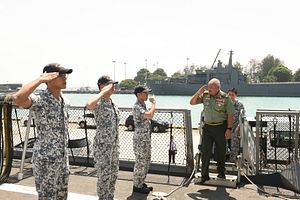This week, Malaysia and Singapore held the latest iteration of one of their military exercises. The interaction cast light on the ongoing military collaboration underway between the two Southeast Asian neighbors despite the lingering challenges in the bilateral relationship amid wider domestic and regional changes at play.
As I have noted before in these pages, though Malaysia and Singapore have had a rather prickly relationship in the past and challenges do arise from time to time, their militaries still interact regularly through various bilateral exchanges and exercises as well as under multilateral arrangements, from the Five Power Defense Arrangements (FPDA), which also consists of Australia, New Zealand, and Britain, to Eyes-in-the-Sky combined air patrols to enhance maritime security in the Straits of Malacca.
That has continued on into 2018 amid wider domestic and regional changes. A shock May election in Malaysia returned Mahathir Mohamad back to the premiership, while Singapore’s holding of the annually rotating ASEAN chairmanship this year to what the country has on its plate in the foreign policy realm, including on security issues, even as it undergoes a gradual, multi-year domestic transition away from the current Prime Minister Lee Hsien Loong.
This month, both sides conduced the 2018 iteration of Exercise Semangat Bersatu. The 24th iteration of the exercise occurred in Kluang in the state of Johor in Malaysia and lasted from November 18 to November 28. The exercise itself occurred over several separate areas as is typically the case.
According to Singapore’s defense ministry (MINDEF), around 980 personnel from the 1st Battalion of the Singapore Infantry Regiment and the 10th Royal Malay Regiment participated in the exercise. The exercise involved the joint planning and execution of a combined battalion mission exercise as well as other interactions and professional exchanges between the two armies, including the cross-training of soldiers on both countries’ weapon systems. It also featured scenarios that enabled both sides to accomplish their intended objectives.
As is typical of such exercises, not much in the way of specifics was revealed about the exact shape of future iterations of the drills. And, to be sure, this is just one of many interactions between the two sides. Nonetheless, as both countries continue to recalibrate their ties amid bilateral and wider regional and global changes, such activities are worth paying attention to within that broader context.
































